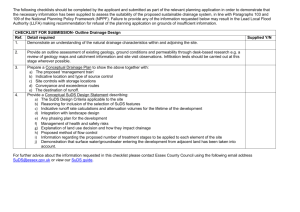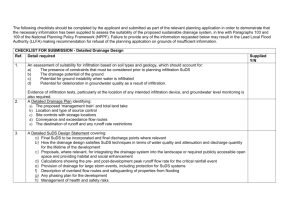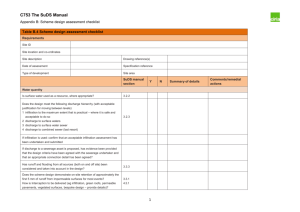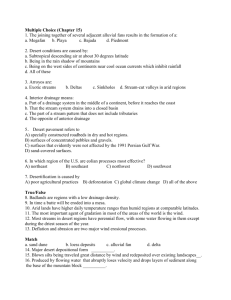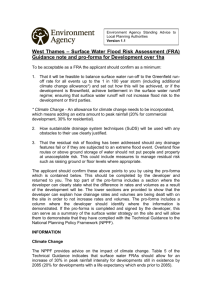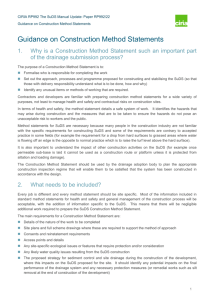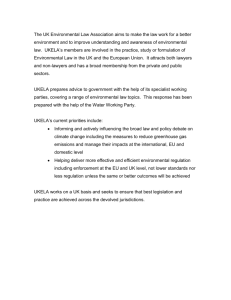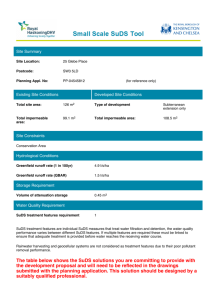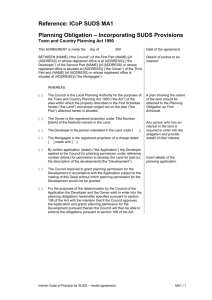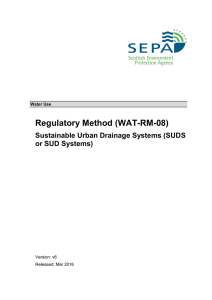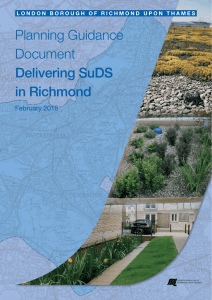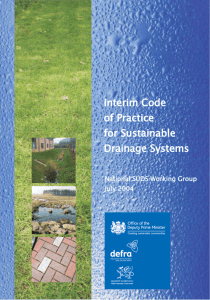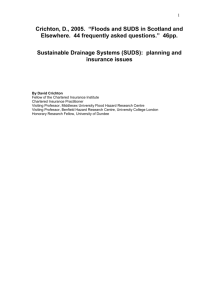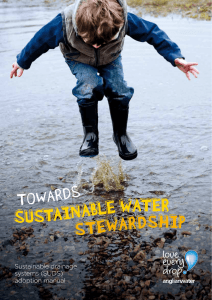SuDS Design Statement Checklist and Guidance
advertisement
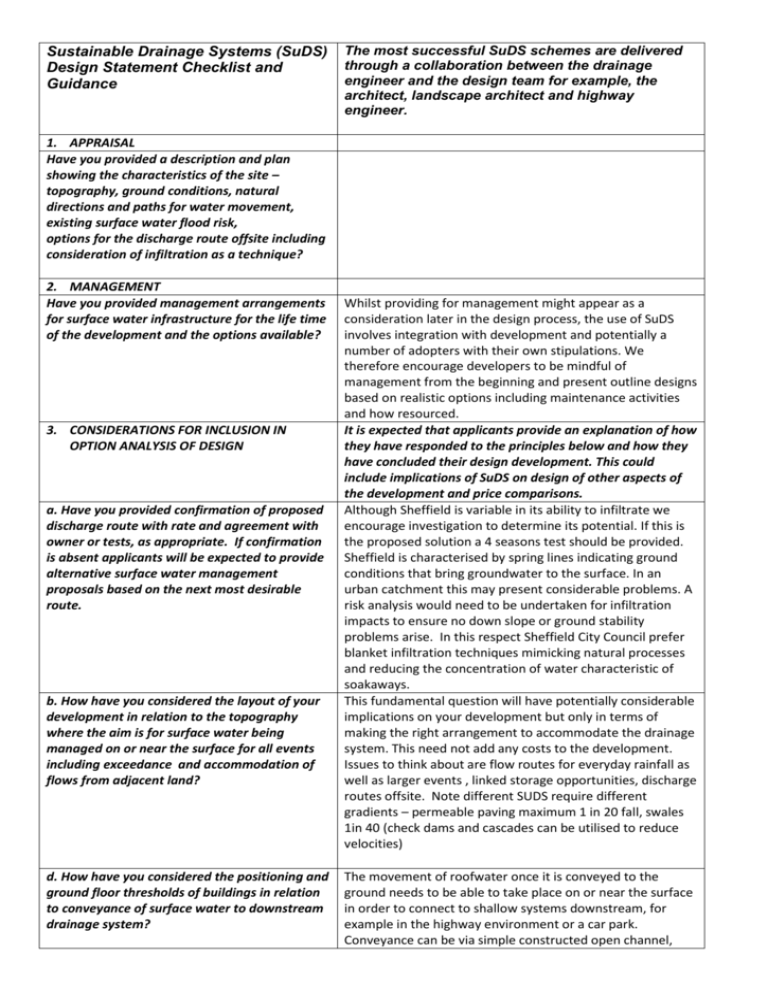
Sustainable Drainage Systems (SuDS) Design Statement Checklist and Guidance The most successful SuDS schemes are delivered through a collaboration between the drainage engineer and the design team for example, the architect, landscape architect and highway engineer. 1. APPRAISAL Have you provided a description and plan showing the characteristics of the site – topography, ground conditions, natural directions and paths for water movement, existing surface water flood risk, options for the discharge route offsite including consideration of infiltration as a technique? 2. MANAGEMENT Have you provided management arrangements for surface water infrastructure for the life time of the development and the options available? 3. CONSIDERATIONS FOR INCLUSION IN OPTION ANALYSIS OF DESIGN a. Have you provided confirmation of proposed discharge route with rate and agreement with owner or tests, as appropriate. If confirmation is absent applicants will be expected to provide alternative surface water management proposals based on the next most desirable route. b. How have you considered the layout of your development in relation to the topography where the aim is for surface water being managed on or near the surface for all events including exceedance and accommodation of flows from adjacent land? d. How have you considered the positioning and ground floor thresholds of buildings in relation to conveyance of surface water to downstream drainage system? Whilst providing for management might appear as a consideration later in the design process, the use of SuDS involves integration with development and potentially a number of adopters with their own stipulations. We therefore encourage developers to be mindful of management from the beginning and present outline designs based on realistic options including maintenance activities and how resourced. It is expected that applicants provide an explanation of how they have responded to the principles below and how they have concluded their design development. This could include implications of SuDS on design of other aspects of the development and price comparisons. Although Sheffield is variable in its ability to infiltrate we encourage investigation to determine its potential. If this is the proposed solution a 4 seasons test should be provided. Sheffield is characterised by spring lines indicating ground conditions that bring groundwater to the surface. In an urban catchment this may present considerable problems. A risk analysis would need to be undertaken for infiltration impacts to ensure no down slope or ground stability problems arise. In this respect Sheffield City Council prefer blanket infiltration techniques mimicking natural processes and reducing the concentration of water characteristic of soakaways. This fundamental question will have potentially considerable implications on your development but only in terms of making the right arrangement to accommodate the drainage system. This need not add any costs to the development. Issues to think about are flow routes for everyday rainfall as well as larger events , linked storage opportunities, discharge routes offsite. Note different SUDS require different gradients – permeable paving maximum 1 in 20 fall, swales 1in 40 (check dams and cascades can be utilised to reduce velocities) The movement of roofwater once it is conveyed to the ground needs to be able to take place on or near the surface in order to connect to shallow systems downstream, for example in the highway environment or a car park. Conveyance can be via simple constructed open channel, shallow covered channels, shallow pipes or vegetated features such as swales e. Have you considered the layout of landscape Sheffield will be looking for proposed landscapes serving a within the site in relation to the topography and water management role, for example site controls within surrounding building and accesses in creating areas below their feeding sub-catchments, adjacent environments for water management? landscapes to hard surfaces serving as capture and conveyance systems. All landscapes should aim to deliver connectivity to allow water to be on or near the surface. The landscape plan in effect should be fundamentally planned and designed around water management unless site conditions are particularly challenging. Depths of storage should be appropriate to a setting, e.g. 300-450mm for formal landscapes in close connectivity to housing. Many of these landscapes provide opportunities for introducing habitat into development. f. How have you considered the depths of receiving systems for vehicular and pedestrian surfaces? Conventional gullied systems push water below the ground making downstream parts deep and therefore based on piped systems. Move water laterally off surfaces into surrounding shallow features or use permeable surfaces to enable immediate cleaning and storage and subsequent shallow discharge. g. Have you considered the levels in and around drainage features to ensure water is deliberately managed along defined flow paths in case of rainfall events beyond the drainage system capacity or blockage? The use of the 30 year event as the determinant of drainage design may continue with SuDS features. If this is the decision overtopping of features needs to be managed on the surfaces in surrounding areas h. Have you considered the opportunities for distributing storage across the development site? Sheffield favour designing systems that are not reliant on one control structure – instead development drainage is designed in sub-catchments with all or a degree of control within each one. Although this creates more points for management we believe this creates a more resilient simple system with risk spread across a number of features. This means run-off rate is nearer to a natural state in being distributed and flows are safely managed across the site rather than conveying uncontrolled flows to a single point. It also means proper capture and treatment of flows can take place. In addition there are the benefits of reducing misconnections as the whole system is visible. i. Have you considered the use of adjacent or nearby open space for water management? The presence of these should be seen as an opportunity to enhance the open space. Evidence will be required to show that the use of this space has been explored with the owner. Use of open space adjacent to your site will more than probably require a separate planning application or an extension of the development boundary j. Have you considered the need for stages of treatment, for example two stages for all vehicular surfaces in housing and car parks? 4. OUTLINE FIGURES AND DRAWINGS Have you provided outline calculations for your site based on discharge rate, impermeable area etc? Have you demonstrated management of site flood risk from surface water up to 1 in 100 plus 30% for climate change Have you provided an outline design plan and critical sections to demonstrate feasibility of solution The shift towards SuDS is very much rooted in protecting receiving watercourse environments from pollutants and doing this in a robust way. Many capture and treatment processes are incidental to the SuDS hydraulic services rather than as happens in conventional systems where they rely totally on management procedures. Sheffield want good watercourse health as part of the value we place on them as assets to the city. Drainage investment is an accumulative process and is for the long-term and needs to be established with this in mind. Two examples of providing two treatment stages are permeable pavement or filter strip and swale combined. Sheffield City Council recommend the use of http://www.uksuds.com/
